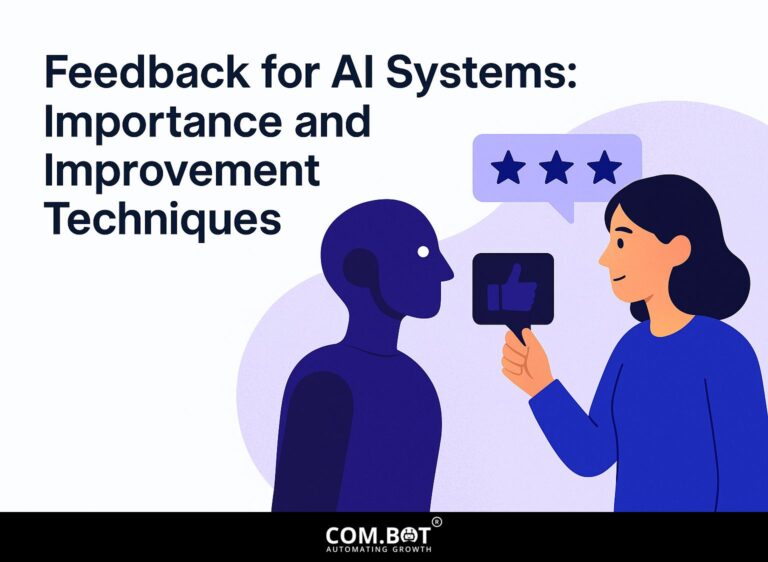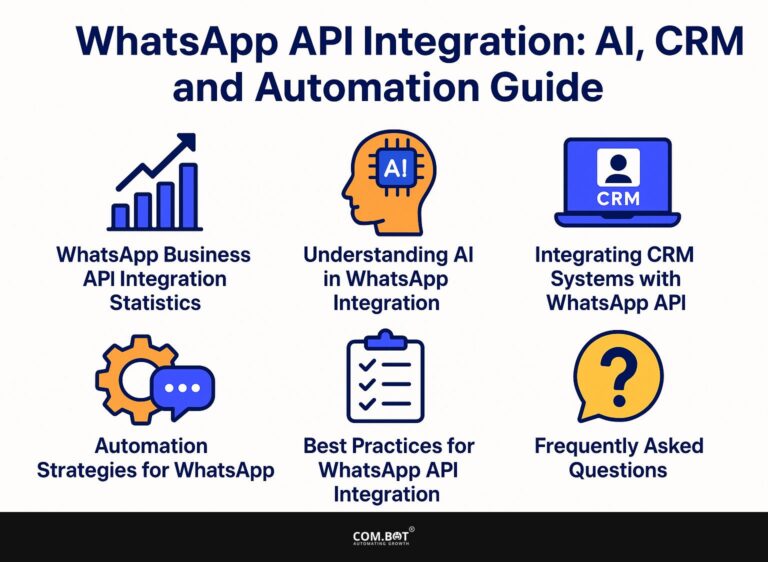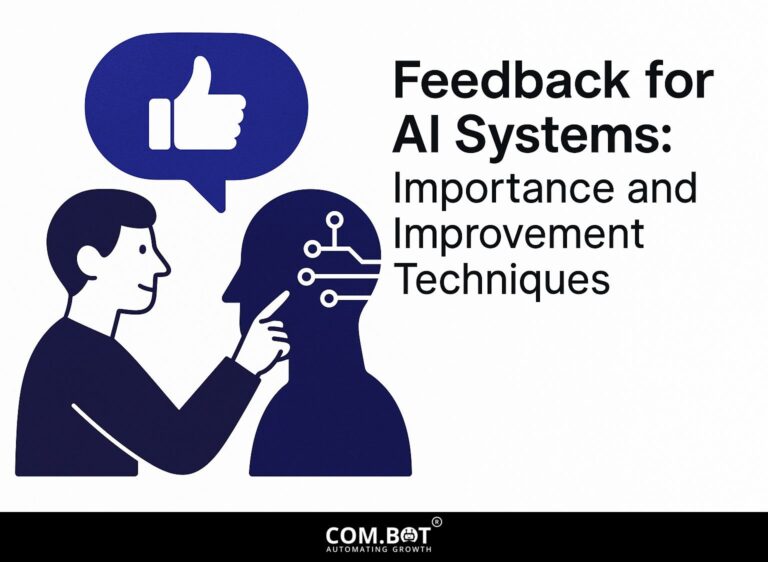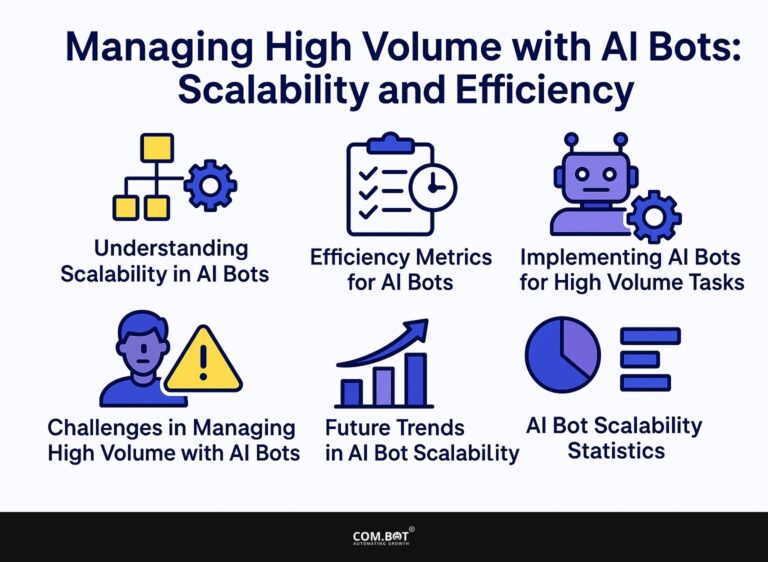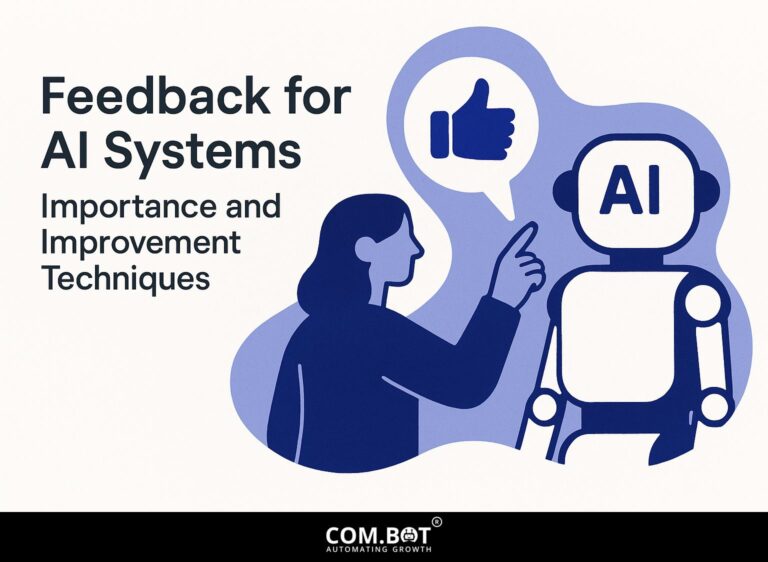Feedback for AI Systems: Importance and Improvement Techniques
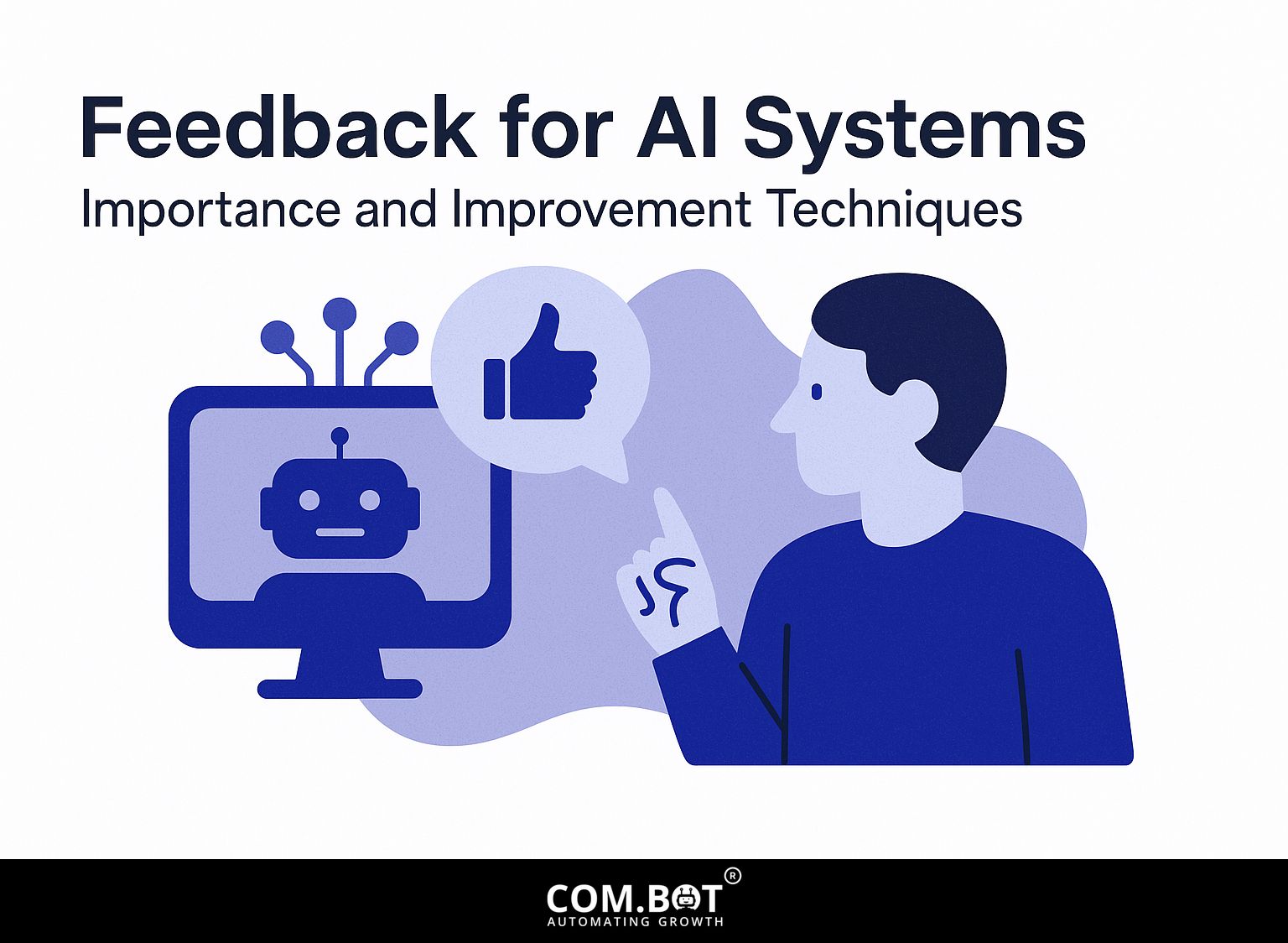
In the fast-changing field of artificial intelligence, it is important to include human feedback in AI systems to make them more dependable and useful. By combining human participation with methods from machine learning and reinforcement learning, we can greatly increase AI capabilities. Tools like Label Studio help improve feedback systems. This article discusses why human feedback matters, gives ways to make improvements, and shows its role in growing AI.
Key Takeaways:
- 1 AI Feedback Loop Statistics
- 2 Importance of Feedback for AI Systems
- 3 Types of Feedback Mechanisms
- 4 Techniques for Collecting Feedback
- 5 Implementing Feedback for Improvement
- 6 Challenges in Feedback Implementation
- 7 Upcoming Trends in AI Feedback Systems
- 8 Frequently Asked Questions
- 8.1 What is the importance of feedback for AI systems?
- 8.2 How does feedback help improve AI systems?
- 8.3 What are some techniques for providing feedback to AI systems?
- 8.4 Why is it important to use diverse and unbiased feedback for AI systems?
- 8.5 Can feedback be used to address ethical concerns with AI systems?
- 8.6 How can businesses and organizations benefit from using feedback to improve their AI systems?
Definition of Feedback
In AI, feedback is the information given to algorithms about how well they are doing, which helps make their results better.
To get feedback fast, use tools like Label Studio that let you set up flexible data labeling processes. This tool supports various input types and offers multiple exporting options.
Encourage users to provide ratings and comments on generated outputs, which can directly inform algorithm training. Segment feedback by demographics to identify performance discrepancies across user groups.
By carefully examining this data, you can make specific changes to improve the model’s accuracy and overall performance.
Role of Feedback in AI Development
Feedback plays a key role in AI progress, particularly in reinforcement learning. It aids algorithms in refining how they make decisions.
For example, in healthcare diagnostics, AI systems study patient information to find trends, and feedback from doctors is important for improving these models.
When doctors fix the AI’s diagnoses, the system improves its predictions. Recommendation systems, like the ones Netflix uses, change their suggestions based on what users do-if someone skips a recommended movie, the algorithm changes what it suggests next. To dive deeper into these processes, our detailed exploration on feedback for AI systems highlights its importance and the techniques used to enhance AI efficiency.
These feedback processes help AI improve accuracy gradually, which improves user experiences in different fields.
AI Feedback Loop Statistics
AI Feedback Loop Statistics
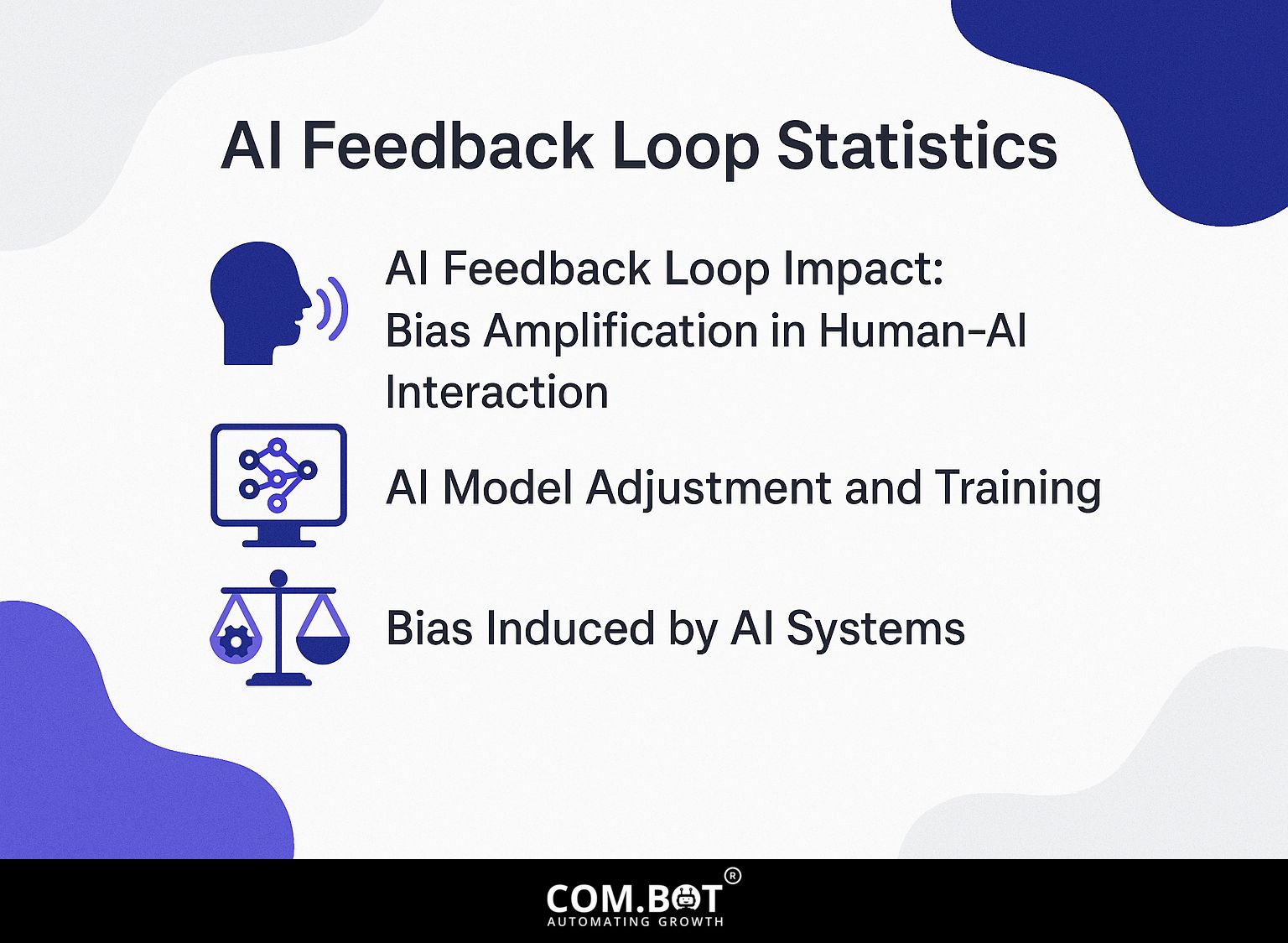
Understanding the intricacies of AI feedback loops is crucial for optimizing machine learning models. Related insight: Feedback for AI Systems: Importance and Improvement Techniques
AI Feedback Loop Impact: Bias Amplification in Human-AI Interaction
AI Feedback Loop Impact: AI Model Adjustment and Training
To further improve AI systems and reduce errors, incorporating feedback mechanisms is crucial. For more insights on this, consider exploring the Feedback for AI Systems: Importance and Improvement Techniques.
AI Feedback Loop Impact: Bias Induced by AI Systems
The AI Feedback Loop Statistics Provide information on how artificial intelligence affects bias increase, accuracy in models, and changes in AI systems. These measurements are essential for figuring out how changes in AI and human interactions can both reduce and continue biases.
Bias Amplification in Human-AI Interaction shows significant data on how AI affects human biases. Interaction with AI increases human bias by 65.33%, compared to a 54.8% increase in human-human interactions and a 56.3% increase in human-AI interactions. This suggests that while AI systems are created to be neutral, they can accidentally make existing biases stronger, probably due to initial bias in data training or built-in biases in algorithms.
AI Model Adjustment and Training focuses on improving AI system performance. AI classification accuracy on test data stands at an impressive 96.0% This shows the accuracy that can be reached with properly trained models. Accurate AI interactions also help lower mistakes by 1.55%, highlighting the potential for AI systems to improve over time with continued training and iteration.
Bias Induced by AI Systems addresses the biases originating from specific algorithmic tasks. A 5.03% rightward bias is induced by a biased RDK task algorithm, indicating that algorithmic adjustments are necessary to reduce skew. On the positive side, an accuracy improvement of 3.55% Using a more accurate RDK task algorithm shows that improving the algorithm’s accuracy can increase the system’s performance.
These statistics show that AI can both reduce and increase biases. By learning about these factors, developers can create AI systems that reduce bias and improve accuracy, supporting fair and efficient AI-human interactions.
Importance of Feedback for AI Systems
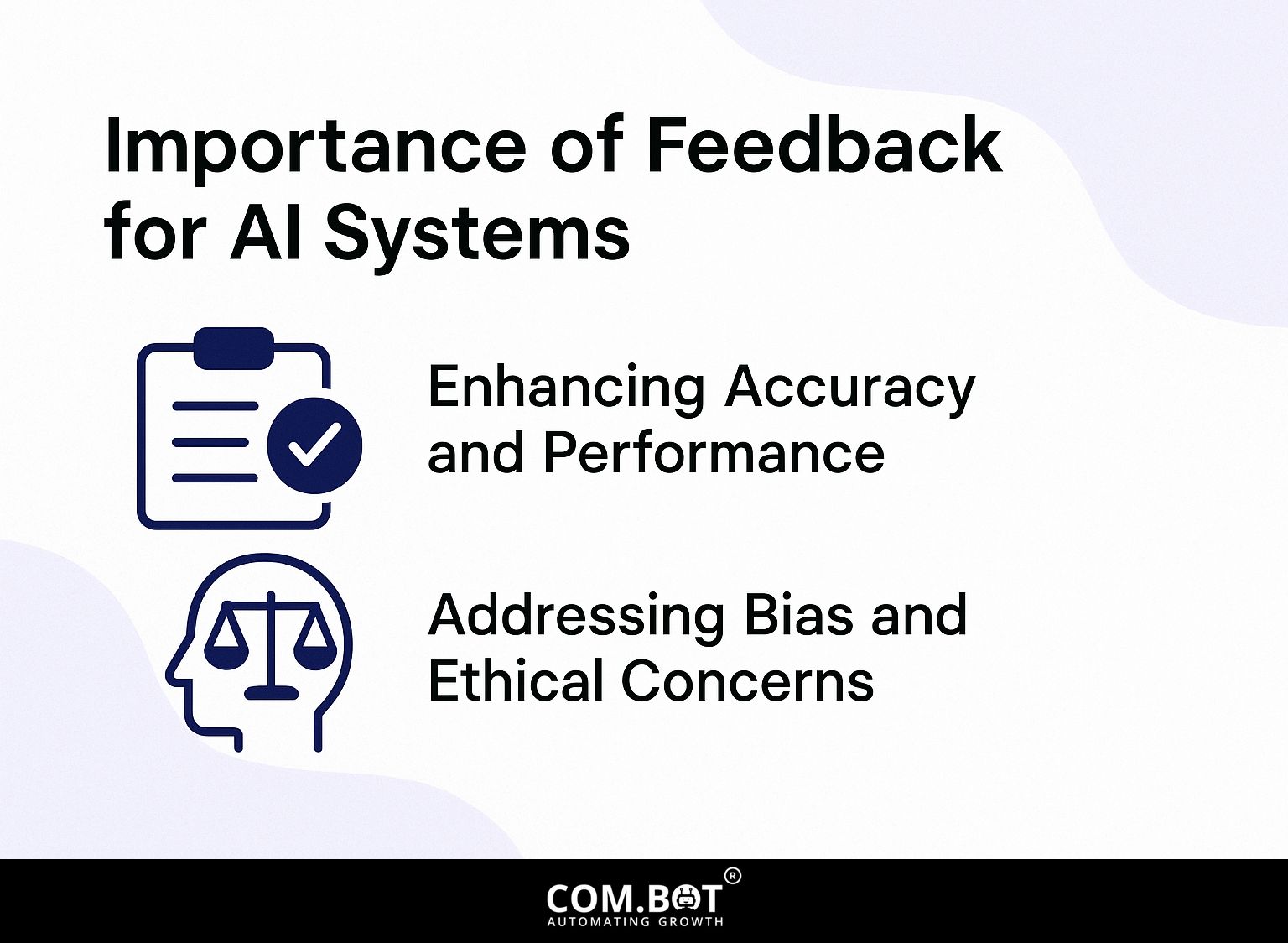
Building strong feedback systems greatly improves the accuracy and performance of AI, which leads to higher user satisfaction and better operational efficiency.
Enhancing Accuracy and Performance
Effective feedback systems can improve AI model accuracy by up to 30%, especially when they include live user input and tracking of performance measurements.
Use tools like Google Analytics to monitor how users interact with your site and what they do, so you can learn which features are most popular.
Implement feedback forms in your application, enabling users to report issues or suggest improvements directly.
Testing different versions of features can give clear data on what users like, helping to make changes to the model.
Regularly check these metrics and change your strategies to improve user satisfaction and performance, leading to ongoing progress.
Addressing Bias and Ethical Concerns
Feedback loops are important for reducing cognitive biases in AI systems, which supports ethical decisions and data fairness.
By collecting diverse user feedback throughout the AI lifecycle, organizations can identify and address biases effectively. For instance, a case study from the hiring sector demonstrated that feedback from rejected candidates highlighted gender biases in the resume screening algorithm. This led to an examination of the training data, resulting in a more equal mix of applicants.
Similarly, a law enforcement AI tool faced scrutiny after biased crime prediction outcomes. Regular audits and community input resulted in re-evaluating the algorithms, promoting transparency and trust.
Involving stakeholders is important for better AI ethics.
Types of Feedback Mechanisms
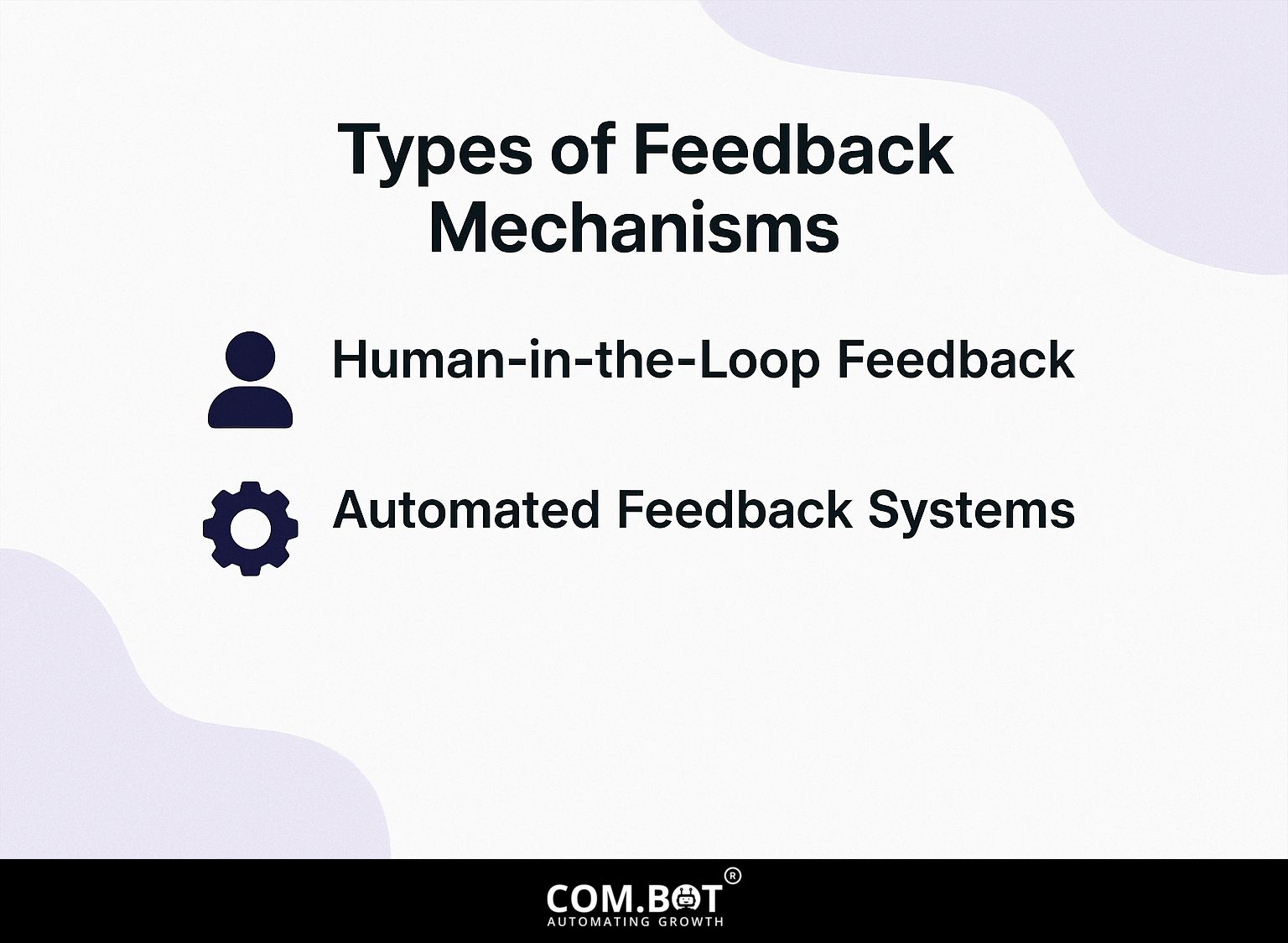
AI systems can receive feedback through different methods, and each method offers specific benefits for various situations.
Human-in-the-Loop Feedback
Human-in-the-loop feedback systems put human supervision into AI processes, greatly improving the quality of decisions and user satisfaction.
These systems use tools like Label Studio for data labeling, where people review the training data to confirm it is correct and helpful.
By involving humans, model performance improves, particularly in supervised learning tasks like image recognition or sentiment analysis.
For example, use Label Studio with platforms like Amazon SageMaker to simplify the training process. This integration improves the AI’s accuracy and enables fast adjustments based on user feedback, creating a more reliable and adaptable system.
Automated Feedback Systems
Automated feedback systems use performance measurements and algorithms to instantly change AI behaviors without human intervention.
These systems use user feedback to improve results. For example, Amazon’s recommendation engine analyzes browsing and purchasing history to suggest products that align with individual preferences.
Tools like Google Analytics use user interaction data to change website content and features in real time. By implementing machine learning algorithms like reinforcement learning, these systems continually improve based on feedback loops, enhancing user experience and operational efficiency.
Over time, businesses can see increased user satisfaction and higher conversion rates as a result of fine-tuned AI responses.
Techniques for Collecting Feedback
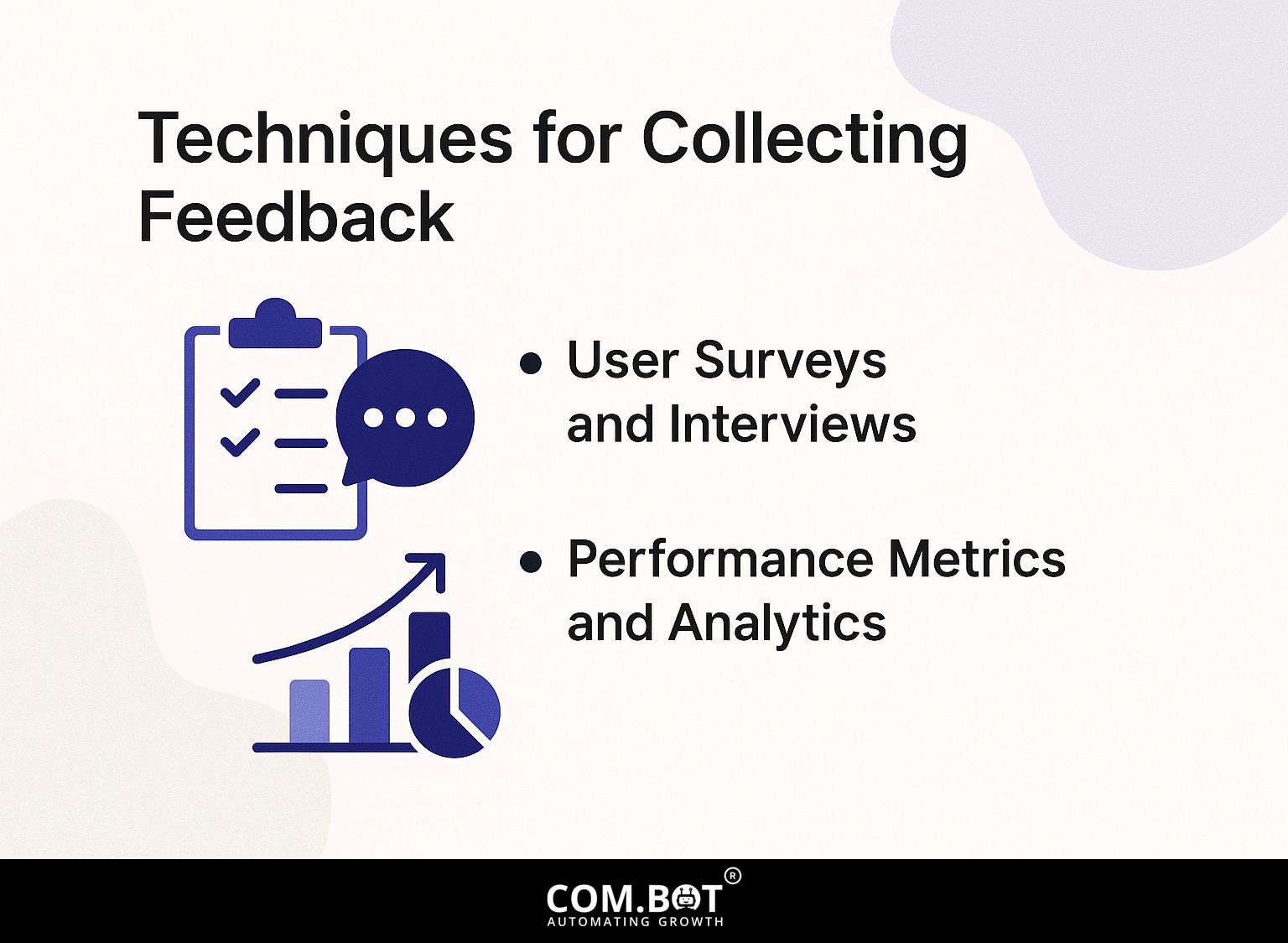
Gathering useful feedback is important for the ongoing improvement of AI systems. This involves using different methods to collect helpful opinions from users.
User Surveys and Interviews
Surveys and interviews with users can give AI developers useful information about what users experience and expect.
To run useful user surveys, start by defining your goals-what specific information are you looking for? Use tools like SurveyMonkey for detailed survey design, or Google Forms for simple, no-cost choices.
Aim for a response rate of 20-30% by promoting the survey through social media and community forums. After collecting responses, analyze the data for common themes and actionable feedback.
Regularly applying new ideas can greatly improve product features and increase user satisfaction, directly impacting your development process.
Performance Metrics and Analytics
Utilizing performance metrics and analytics tools allows AI developers to measure the effectiveness of their systems and make data-driven improvements.
Developers should focus on key performance indicators (KPIs) such as accuracy scores, which reveal how often the AI’s responses align with correct outputs, and response times, indicating the system’s speed.
Tools like Google Analytics can track user engagement metrics, while Tableau is excellent for visualizing data trends. For instance, by analyzing error rates across different scenarios, developers can pinpoint areas needing optimization.
Checking these measurements often helps make AI models and user experience better over time.
Implementing Feedback for Improvement
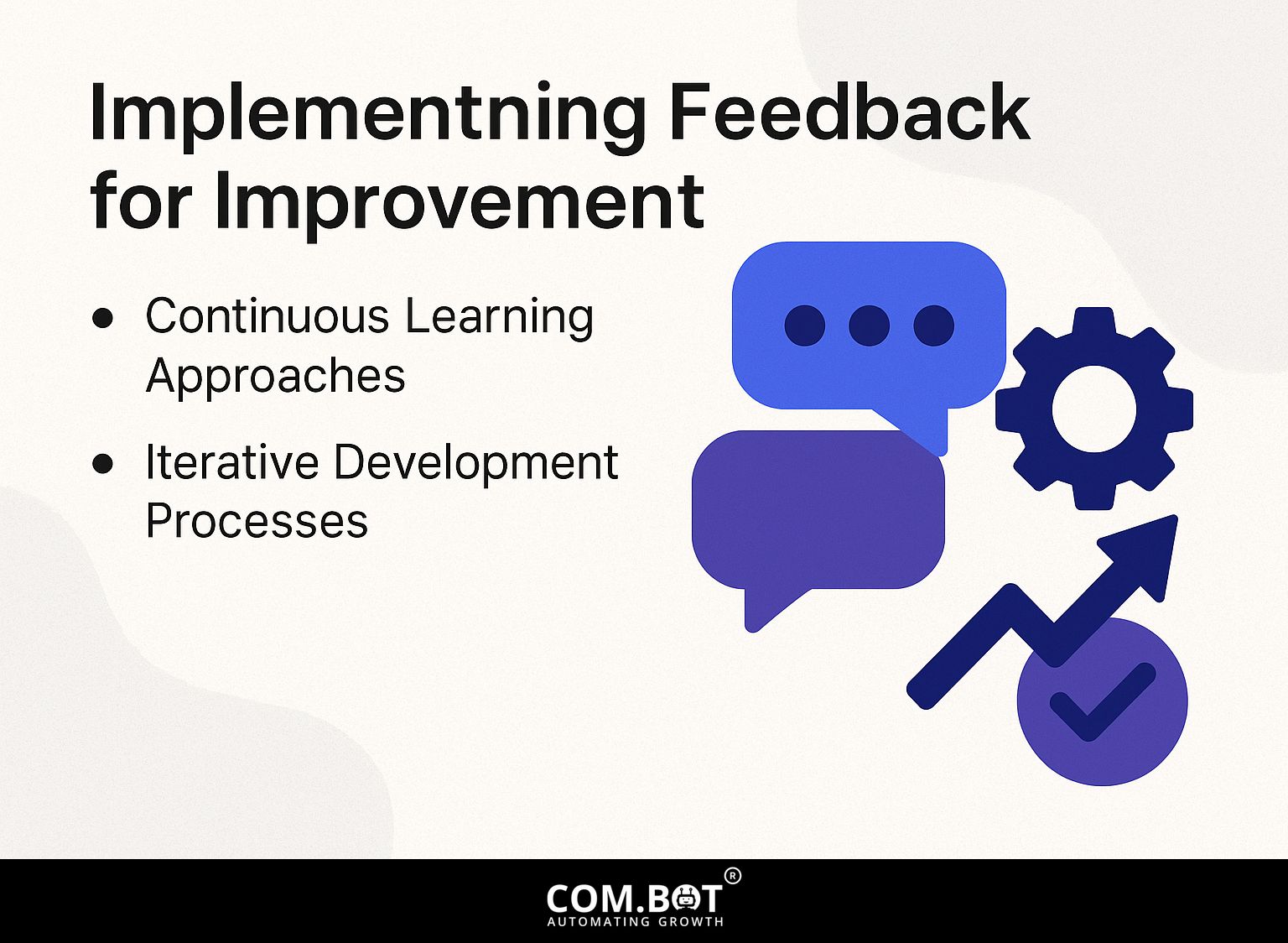
Successfully putting feedback into practice needs an organized method.
This involves ongoing learning and repeated improvements to improve AI skills.
Continuous Learning Approaches
Continuous learning methods allow AI systems to change and improve by using user interactions and immediate feedback, leading to constant development.
For example, companies such as Amazon and Netflix use live information to constantly improve their recommendation systems.
Amazon uses customer buying and browsing habits to quickly improve its product recommendations, which increases user happiness and sales. Netflix examines viewing habits to change movie recommendations for a more personalized experience.
Programs like TensorFlow and PyTorch can be used to set up systems that continually learn, allowing you to take in and respond to live data quickly.
Iterative Development Processes
Building AI models in stages allows for continuous improvement, ensuring they satisfy user requirements and perform effectively.
To implement this, start with a prototype and gather user feedback after initial testing.
Use tools like GitHub for version control, where team members can suggest changes via pull requests.
After using feedback, do another test to check the changes made. Getting feedback, making updates, and testing again makes the AI model better and encourages working together.
It leads to a product that better matches user needs and is simpler to use.
Challenges in Feedback Implementation
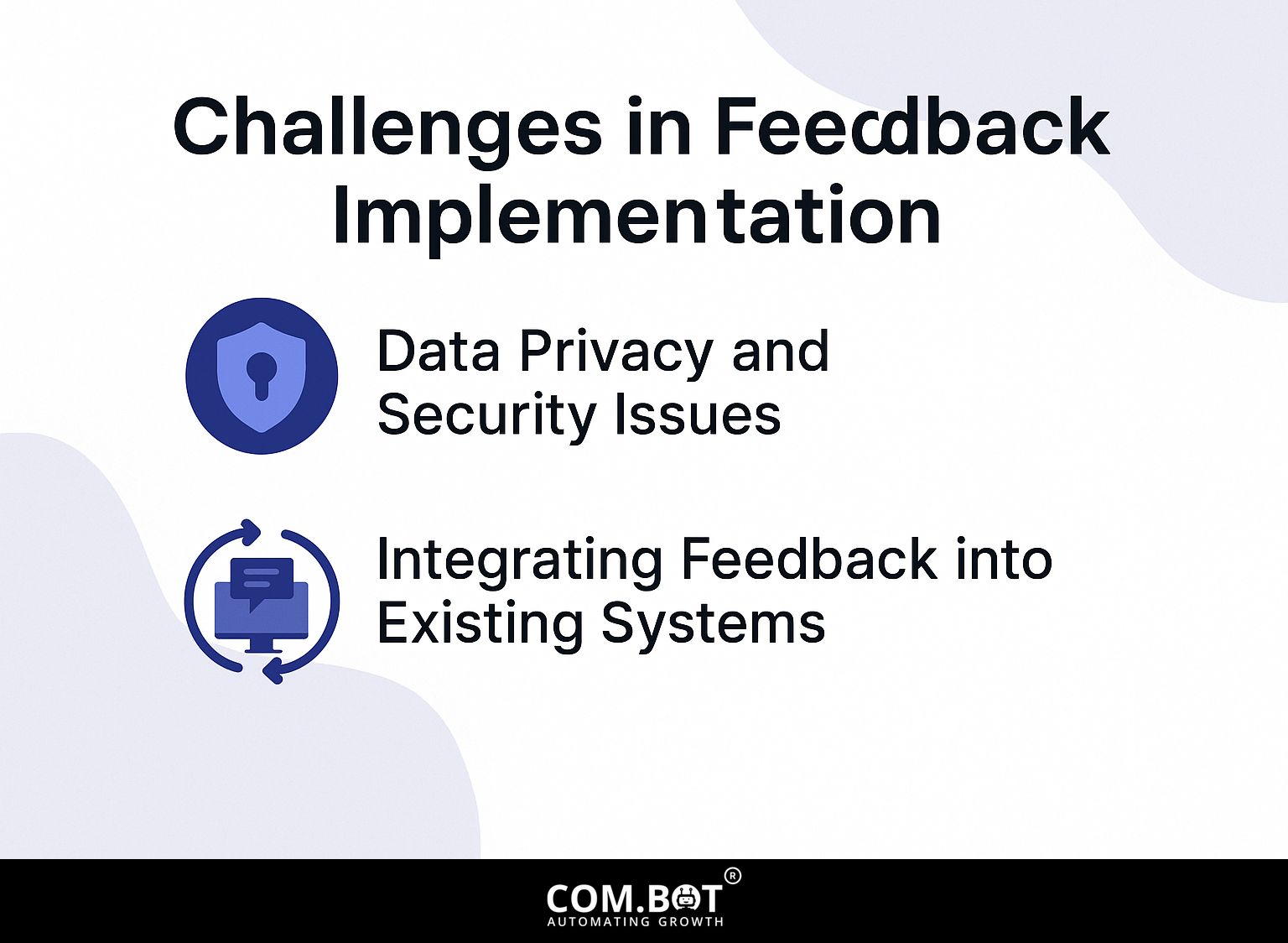
Even though they are helpful, setting up ways to get feedback in AI systems brings various difficulties that organizations need to handle with care. Worth exploring: Feedback for AI Systems: Importance and Improvement Techniques
Data Privacy and Security Issues
Keeping data private and secure is very important when gathering feedback, so strong measures must be in place to protect user information.
Organizations must adhere to regulations like GDPR, which mandates strict user consent and data handling practices.
For instance, a company should implement clear opt-in mechanisms that inform users how their data will be used.
Using feedback tools like Typeform or SurveyMonkey, which offer GDPR compliance options, can simplify adherence.
Make sure to frequently review your feedback systems to verify and allow users to access or delete their data upon request.
This builds trust and reduces legal risks related to data leaks.
Integrating Feedback into Existing Systems
Integrating feedback into existing AI systems can be complex, requiring careful alignment of feedback mechanisms with current technologies and processes.
Begin by identifying specific feedback sources, such as user surveys or performance analytics.
Next, choose tools like Airtable for organizing feedback data or Trello to track the implementation of changes. Get stakeholders involved early; their opinions help create effective feedback systems.
Possible challenges include people not wanting to change and having too much information. To address this, clearly explain the advantages and focus on getting useful feedback. Concentrate on a few important measurements to prevent feeling overloaded.
Regular review cycles, perhaps monthly, can also help in refining these feedback loops for continual improvement.
Upcoming Trends in AI Feedback Systems
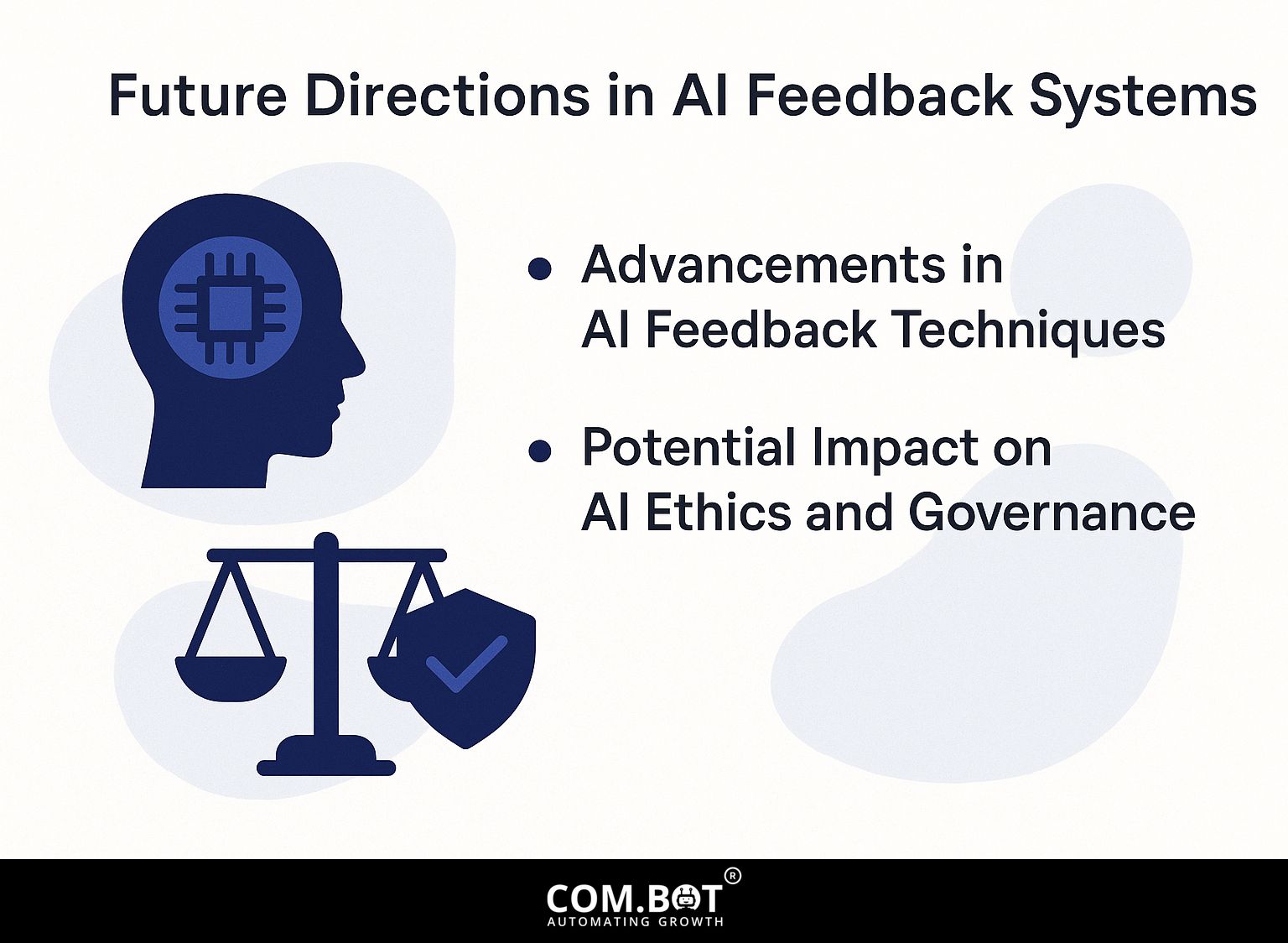
As AI technologies improve, the methods for gathering and using feedback also change, which influences the direction of AI development.
Advancements in AI Feedback Techniques
Recent progress in AI response methods features the use of real-time monitoring systems that change AI outputs based on how users interact.
For example, companies such as Google and Amazon constantly review user activity data to improve their AI suggestions.
Google employs A/B testing combined with user feedback to determine the most effective algorithms for search results. Just like Amazon, the pricing changes instantly, depending on how customers shop and what competitors charge.
To put these methods into action, businesses can use tools like Mixpanel for analyzing customer actions. This allows them to collect information and make quick adjustments, which helps to steadily improve AI performance.
Potential Impact on AI Ethics and Governance
Changes in how AI systems get and handle feedback affect ethics and rules. This means we need new ways to make sure they are responsible.
Industry experts, such as those from the Partnership on AI, recommend establishing clear feedback loops that include diverse stakeholder voices, emphasizing transparency and fairness.
For example, organizations can frequently check AI models to make sure they comply with ethical standards. Developing guidelines that dictate when and how feedback is integrated can help mitigate biases.
Tools like Explainable AI (XAI) frameworks help developers demonstrate how decisions are made, which boosts accountability. Using feedback can increase trust and improve how AI is managed.
Frequently Asked Questions
What is the importance of feedback for AI systems?
Feedback for AI systems is important because it helps ongoing improvement and adjustment of how the system works. Without feedback, the system may continue to make the same mistakes or overlook important details, hindering its effectiveness and reliability.
How does feedback help improve AI systems?
Feedback helps make AI systems better by giving useful information to update and change the system’s algorithms. This lets the system improve by learning from errors and making better choices later.
What are some techniques for providing feedback to AI systems?
Some techniques for providing feedback to AI systems include labeling data, correcting errors, and providing ratings or reviews. These methods help to train the system and improve its performance.
Why is it important to use diverse and unbiased feedback for AI systems?
Collecting various clear opinions for AI systems is important because it helps avoid biases or mistakes caused by missing information. By considering various perspectives, the system can become more accurate and fair.
Can feedback be used to address ethical concerns with AI systems?
Yes, feedback can be used to address ethical concerns with AI systems. AI developers can make sure their systems do not cause harm or continue existing biases by gathering feedback and fixing any problems that come up.
How can businesses and organizations benefit from using feedback to improve their AI systems?
Businesses and organizations can benefit greatly from using feedback to improve their AI systems. It can help make better decisions, increase customer happiness, and give a market advantage.
